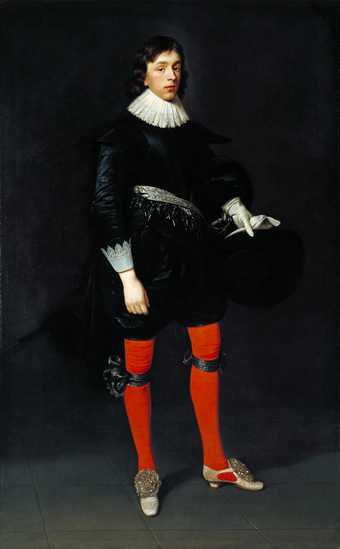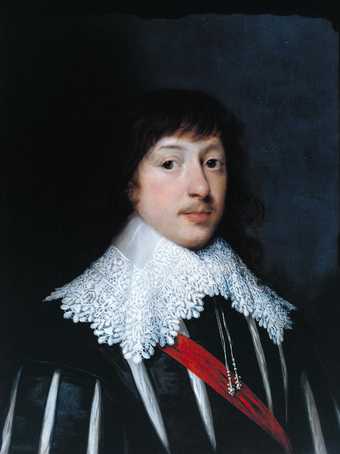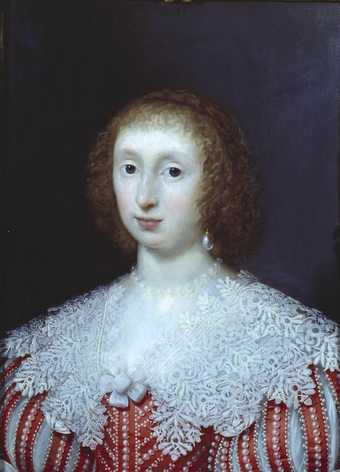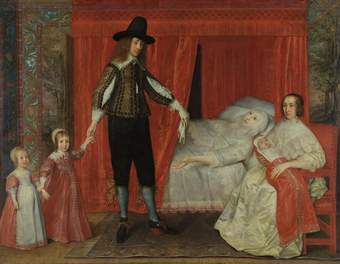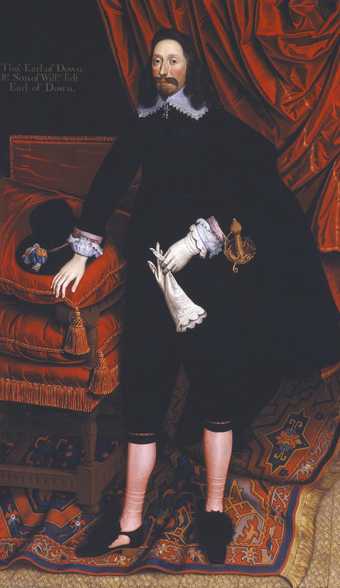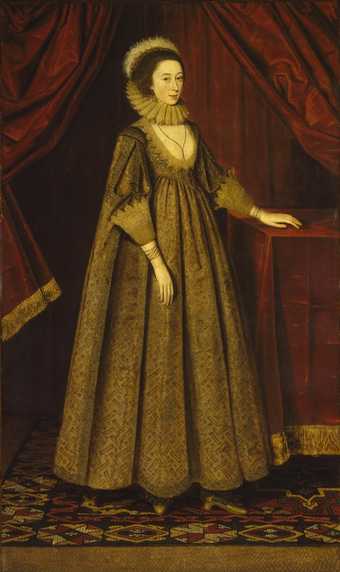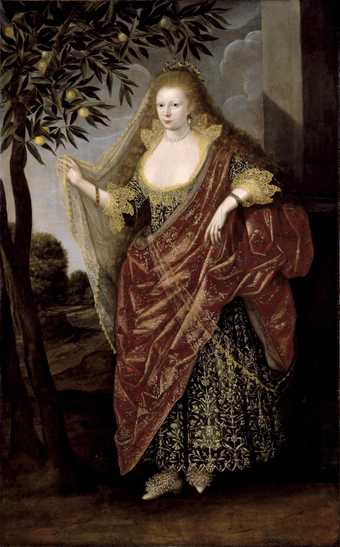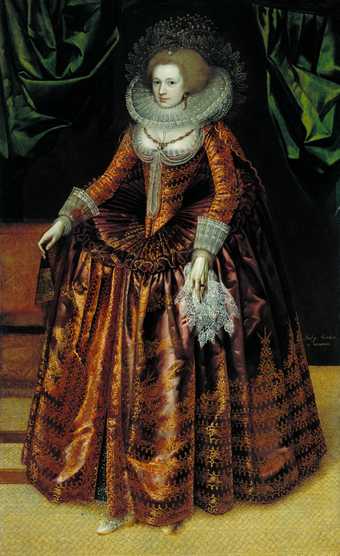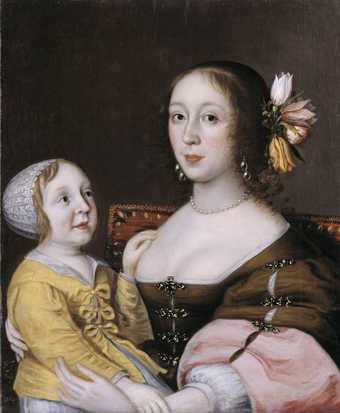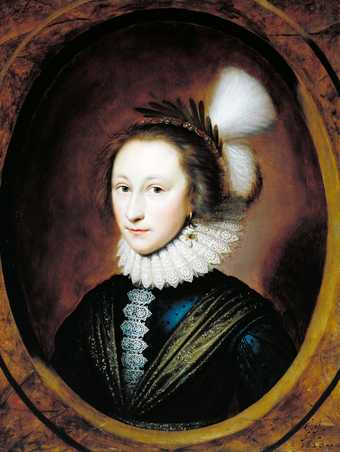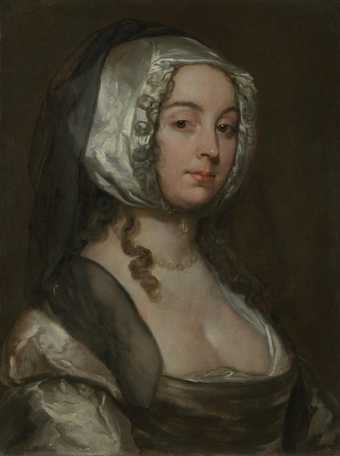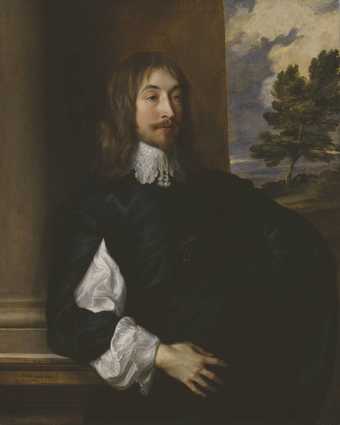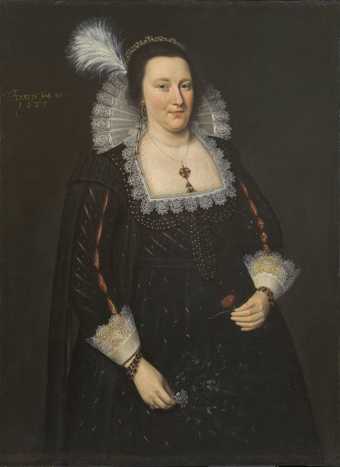
In Tate Britain
- Artist
- Unknown artist, Britain
- Medium
- Oil paint on canvas
- Dimensions
- Support: 2051 × 1359 mm
frame: 2320 × 1635 × 105 mm - Collection
- Tate
- Acquisition
- Purchased 1978
- Reference
- T02308
Summary
William Style (1599/1600 or 1603-79) was the son of William Style of Langley, Kent and his second wife Mary, daughter of Sir Robert Clarke, Baron of the Exchequer. He matriculated from Queen's College, Oxford in 1618, aged 15, and became a student at the Inner Temple in London that same year, completing his legal training as a barrister in 1628.
During his legal career, Style published some minor works on law and, in 1640, a translation from the Latin of a devotional handbook by the Nuremberg humanist and theologian Johann Michael Dilherr, entitled Contemplations, Sighes and Groanes of a Christian, the original of which had first been published in Jena in 1634.
Many features in this portrait closely echo Dilherr's text. It may have even been painted while Style was working on his translation - his preface is dated 'From my chamber in the Inner Temple August 20 1639', and the date '1636' over the archway in the painting could commemorate the year of Style's entrance into a new understanding of religious life at that time. It was this which led him to embark upon the translation. His text is an exhortation in very elaborate language to abandon worldly vanities for a more Christian life. In it he uses the garden as an analogue for the church.
In accord with these sentiments Style, in this painting, turns his back on his worldly possessions, starting with his coat-of-arms set in the window, top left, reinforced with the Latin motto underneath 'vix ea nostra voco' ('I scarcely call these things my own'). In further echoes of Dilherr's text, Style also turns away from his books and writing, his outer garments and a chair, and from worldly music in the shape of a small violin of the type used by dancing-masters. Behind him is the classical archway which makes no sense architecturally, but perhaps represents the entrance to the garden of the Church, a metaphor particularly common in Catholic literature. The garden is protected by a green hedge from the mountainous wilderness beyond. The latter is dominated by an antique ruin, symbolising, perhaps, the pagan world.
The costly black-and-white floor is a feature more commonly seen in Dutch paintings of this period, although it is now thought that very few such floors existed in reality. The curious object and the Latin motto at his feet, to which Style so purposefully points with his cane, would have been easily understood by his contemporaries: 'Microcosmus Microcosmi non impletur Megacosmo' can be translated as 'The microcosm (or heart) of the microcosm (or man) is not filled (even) by the megacosm (or world)' - that is to say that the human heart is not sated with the whole created world, but only with its Creator. This image of a globe within a burning heart could have been inspired by Peter Heylyn's Microcosumus. A little description of the Great World, 1621. Heylyn and Style overlapped as students at Oxford University (Heylyn matriculated in 1617 and subsequently became a high-churchman). However, as Dixon Hunt has pointed out, the image of the world within a heart was also a favourite image of the radical sect, the Family of Love, groups of which worshipped in secret in late Elizabethan and Jacobean England (Dixon Hunt, pp.301-3).
It has not yet proved possible to identify the painter of this remarkable work, although it shows some resemblance to the work of the British portraitist Edward Bower (active c.1636-67) whose first definitely identified painting dates from 1636. At some time during the 1630s, Bower may have worked as an assistant to Sir Anthony van Dyck (1599-1641). Bower is known to have had a studio located at Temple Bar, in London, at the junction of the Strand and Fleet Street, which would have been conveniently close to Style's quarters at the Inner Temple.
Further Reading:
Tate Gallery Acquisitions 1978-80 , London 1981, pp.4-6 (where reproduced, p.4, in reverse)
John Dixon Hunt, 'The Portrait of William Style of Langley: Some Reflections', John Donne Journal, vol.5, nos.1-2, Raleigh North Carolina 1986, pp.291-310
Karen Hearn
December 2001
Does this text contain inaccurate information or language that you feel we should improve or change? We would like to hear from you.
Display caption
Style was a lawyer involved in the Counter-Reformation religious movement and his portrait is full of symbolic elements. The emblem on the floor and its motto proclaim that the human heart cannot be satisfied by worldly matters, but burns for the spiritual life. Style therefore turns his back on the trappings of his earthly life, represented by his family arms set in the window, by his books and writings and by the small violin. Instead, he moves towards the Church, symbolised by a closed garden, beyond which lies a pagan wilderness, including a classical ruin.
Gallery label, February 2016
Does this text contain inaccurate information or language that you feel we should improve or change? We would like to hear from you.
Catalogue entry
T02308 WILLIAM STYLE OF LANGLEY 1636
Inscribed ‘1636’ in cartouche over archway; ‘Microcosmus Microcosmi non impletur Megacosmo’ bottom right above globe on floor, and ‘vix ea nostra voco’ below coat-of-arms in window top left
Oil on canvas 80 3/4 × 53 1/2 (205 × 136)
Purchased (Grant-in-Aid) 1978
Prov: Presumably painted for the sitter and by family descent to Sir Charles Style, 8th Bt., who sold Wateringbury in 1829 and placed some of the family portraits with his relative James Whatman of Vinters, near Maidstone, Kent; recorded there in a watercolour by Charlotte Bosanquet in 1843; on Sir Charles' death in 1879 inherited by his cousin Sir William Style, 9th Bt., who in 1890 sold the family portraits to his brother Albert F. Style of Boxley House, near Maidstone; thence by descent to David Style, who re-purchased Wateringbury 1946; Wateringbury sale, Christie's, 1 June 1978 (329, repr. in col.), bt. by Leggatt Bros. on behalf of the Tate Gallery.
Lit: Joseph Foster, Alumni Oxonienses, 1891, for Style; J. M. Rigg, article on William Style in Dictionary of National Biography, 1909; Robert Borrowman, Beckenham past and Present, 1910, pp.21, 125, 128, 198, 206, 208; Horatio F. Brown, ‘Inglesi e Scozzesi all’ Università di Padova 1618–1765' in Monografie...del R. Instituto Veneto, Venice, 1922, p.145; B. F. Davis, Transcripts of PCC Wills mainly concerning Bromley, Kent, typescript, 1934, p.88a, in Bromley and Beckenham Central Library, for transcript of W. Style's will; Style family genealogy, MSS in possession of Lt.-Cdr. Sir Godfrey Style, CBE, DSC, RN; James P. Cunningham, Dancing in the Inns of Court, Jordan publications, 1965; John Cornforth, English Interiors 1790–1848, 1978, p.58, fig. 52 for repr. of watercolour by Charlotte Bosanquet (original in Ashmolean Museum, Oxford); The Tate Gallery 1978–80, p.31, repr. in col.
William Style (1599/1600 or 1603–1679) was the son of William Style of Langley, Kent, and his second wife Mary, daughter of Sir Robert Clarke, Baron of the Exchequer. He matriculated from Queen's College, oxford, in 1618, aged 15 (hence the uncertainty about his date of birth, since his memorial plaque in Beckenham parish church describes him as having died on 7 December 1679, in his 80th year), and became a student at the Inner Temple that same year, being called to the bar in 1628. He may have travelled abroad, as the register of English visitors at Padua university recorded a ‘Mattia Styles Inglese’ on 6 July 1625. No Matthew has as yet been found in the Style genealogy for that period, so that in view of the extremely fanciful spelling of English names on this list, ‘Mattia’ could conceivably be a mistake for William. If William travelled, he would have been then a suitable age at which to have done so; his relative ‘Thomas Style Cantianus of Watringbury’ was there in December 1669. During his legal career Style published some minor works on law, and in 1640 a translation from the Latin of a devotional handbook by the Nuremberg humanist and theologian Johann Michael Dilherr, entitled Contemplations, Sighes and Groanes of a Christian, the original of which was first published in Jena in 1634.
Many features in this portrait closely echo Dilherr's text, and it may have even been painted while Style was working on his translation - his preface is dated ‘From my chamber in the Inner Temple August 20 1639’, and the date ‘1636’ over the archway could commemorate Style's entering into some kind of new understanding of religious life at that time, which led him to embark upon the translation. The text is basically a simple exhortation, in very flowery language and using the garden as an analogue for the church, to abandon worldly vanities for a more Christian life. It is clearly summed up in the simple and anonymous frontispiece of the book, which shows a man clutching a volume of the Contemplations seated on a rock above a formal, hedge-encompassed garden, beside a table covered with objects representing the senses, i.e. flowers for smell, bread and wine for taste, lute for hearing etc. He looks up to heaven and utters a quotation from Ovid, Metamorphoses 7.21: ‘I see better (things), but follow (the) worse’ (the compiler is indebted to Dr David Rogers of the Bodleian Library, Oxford, for his kind help in interpreting the quotations and the imagery of the frontispiece and the painting).
In accord with these sentiments, Style turns his back on his worldly possessions, starting with his coat-of-arms set in the window, reinforced with the motto ‘vix ea nostra voco’ (‘I scarcely call these things my own’), and on worldly music in the shape of a kit, or dancing-master's violin. This is not an empty symbol, as Style left in his will ‘to my friend Butler Buggin of the Inner Temple Esq. all my flagaletts, Recorders & Kitts & my small violyn’. The Inns of Court were at this time important musical centres, with elaborate dance entertainments at Christmas and other feasts, which Buggin, who was a younger colleague of Style and more than once Master of the Revels, had a hand in organising (the compiler is indebted to Wallace W. S. Breem, Librarian and Keeper of Manuscripts of the Inner Temple, for this information). The rest of the programme also echoes Dilherr's text: Style turns away from his books and writing (‘I will therefore rest from the too much desire of knowledge’), his outer garments (‘O vaine mantles, O lamentable coverings!...nothing can hide me from God's judgement, but thy coat, O heavenly Lambe’), and a chair (‘I aske not to sit, but to stand and observe thy commandments’). He turns towards an archway which makes no architectural sense but presumably represents the way into the garden of the Church, a common image particularly in Catholic and counter-reformation literature, although it might be fanciful to suggest that the discordant pattern of what should be regular and formal beds is meant to be emblematic of the evils which happen ‘even within the Orchyard of the Church’, according to Dilherr's preface. The emblematic use of the garden was particularly popular at this time, partly through the publication of Henry Hawkins' Partheneia Sacra in 1633, with its discourse on the garden as a marian hortus conclusus and a place for ‘heavenlie Contemplations’. The garden is, however, protected by a green hedge from the mountainous wilderness beyond, which is dominated by the ruins of pagan antiquity. The object and motto at his feet to which Style so purposefully points with his cane would have been easily understood by his contemporaries: ‘The microcosm (or heart) of the microcosm (or man) is not filled (even) by the megacosm (or world)’ - that is to say that the human heart is not sated with the whole created world, but only with its Creator. This image of a globe within a burning heart could have been inspired by Peter Heylyn's Microcosmus. A little description of the Great World., 1621, as Heylyn and Style overlapped at Oxford (Heylyn matriculated in 1617) and the former was a high-churchman and divine with counter-reformation sympathies. From the arrangement of the lines, however, it is likely that the artist did not use a globe, but a current circular world map such as that of the Mercator/Hondius world atlas of 1633, where the down-curving ecliptic and position of ships and cartouche correspond with the lines on the painted globe. (The compiler is indebted to Helen Wallis of the British Library and Christopher Terrell of the National Maritime Museum for these suggestions.)
In spite of the considerable quality of this work, it has so far proved impossible to attribute it to any particular artist. It shows a marked Flemish influence, combined with certain archaic qualities and a flatness of modelling that have come to be associated with the provincial British school: on the one hand the sensitive head seems to show something of the influence of Cornelius Johnson, and there is a certain sophistication in placing the figure between two sources of light; on the other, details like the rough painting of the middle distance, the uncertain understanding of perspective and light, as well as the deliberate use of script as part of the composition - a very old-fashioned device by this time and never employed by contemporary fashionable court painters like Van Dyck - hark back to the Jacobean mode of Gheeraedts and Peake. It is very likely that the painter will turn out to be a member of the complex community of expatriate Flemish artists residing in London, so ably charted by Mary Edmond (see her ‘Limners and Picturemakers’, Walpole Society, 1978–80, vol. XLVII, p.6off.) but examples of whose works are as yet rarely identified. There is, for instance, Cornelius De Neve, a painter associated with the De Critz family of painters, whose few known works (e.g. the ‘Richard Sackville, Lord Buckhurst and the Hon. Edward Sackville’, signed and dated 1637, at Knole) would seem to fall well within the competence of the Style portrait. Other comparisons remain to be made (The compiler wishes to thank David Style and Jonathan Vickers for their help in tracing the history of T02308).
Published in:
The Tate Gallery 1978-80: Illustrated Catalogue of Acquisitions, London 1981
Explore
- architecture(30,960)
- garden structures(1,939)
-
- garden(1,191)
- periods and styles(5,198)
-
- classical(1,040)
- townscapes / man-made features(21,603)
-
- building - non-specific(3,161)
- universal concepts(6,387)
-
- wealth(22)
- clothing and personal items(5,879)
-
- cane / walking stick(118)
- cloak(192)
- collar(88)
- glove(94)
- hat(1,437)
- book - non-specific(1,954)
- coat of arms(102)
- sword(212)
- actions: expressive(2,622)
-
- pointing(185)
- standing(3,106)
- man(10,453)
- individuals: male(1,841)
- Judaeo-Christian imagery(856)
-
- redemption(8)
- phrase(100)
- crime and punishment(431)
-
- lawyer(159)
You might like
-
Daniel Mytens the Elder Portrait of James Hamilton, Earl of Arran, Later 3rd Marquis and 1st Duke of Hamilton, Aged 17
1623 -
Cornelius Johnson Portrait of an Unknown Gentleman
1629 -
Cornelius Johnson Portrait of an Unknown Lady
1629 -
David Des Granges The Saltonstall Family
c.1636–7 -
Unknown artist, Britain Portrait of Sir Thomas Pope, Later 3rd Earl of Downe
c.1635 -
Unknown artist, Britain Gertrude Sadler, Lady Aston
c.1620–3 -
Unknown artist, Britain Portrait of a Lady, Called Elizabeth, Lady Tanfield
1615 -
Unknown artist, Britain Portrait of Anne Wortley, Later Lady Morton
c.1620 -
Gilbert Jackson A Lady of the Grenville Family and her Son
1640 -
Cornelius Johnson Portrait of Susanna Temple, Later Lady Lister
1620 -
Marcus Gheeraerts II Portrait of a Woman in Red
1620 -
William Dobson Portrait of the Artist’s Wife
c.1635–40 -
Sir Anthony Van Dyck Portrait of Sir William Killigrew
1638 -
Sir Anthony Van Dyck Portrait of Mary Hill, Lady Killigrew
1638 -
Adam de Colone Portrait of Lady Margaret Livingstone, 2nd Countess of Wigtown
1625

